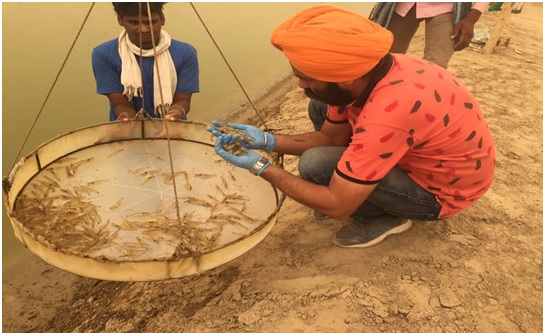On the land of five rivers known as Punjab (only 1.57% geographical area of India) has famous for their agriculture and milk production which cover the large portion of the state economy. With the time, the human activities has been increased such as agricultural land used for construction of buildings and roads, use of excessive pesticides and chemicals in the farming to increase production, introduction of hybrid and exotic varieties that have a massive impact over the native species and use of excessive water for agriculture could potentially disrupt the ecosystem which results drought condition, developing the resistant bacterial stain, pesticides residue, industrial effluents, microplastics hazard, degradation of the soil and water quality, nutrient imbalance (N, P, K and other productive elements) and heavy metals and high salinity in South-west district of Punjab.
Salt-affected waterlogged area
There are two major states, Punjab and Haryana that affecting from the salt waterlogged area in northern India. The irrigation of the southwest districts Fazilka, Sri Muktsar Sahib, and Bathinda for agriculture farming is depending upon the canals; Sirhind and Rajasthan through Ghaggar, which is almost a seasonal river, flows through the southwestern part of Punjab. The major impediment is emerging the waterlogging and salinization which affect to the sustainability of irrigated lands and livelihoods of the farmers. Further, its include seepage from unlined earthen canals system, inadequate provision of surface and subsurface drainage, poor water management practices, insufficient water supplies and use of poor quality groundwater for irrigation. The application of the excess irrigation and water distribution network causes the gradual rise of water table up to 2m of the soil surface, the root zone available to plants becomes restricted and salts rise to the surface by capillary action. Over the thirty decades, the groundwater table becomes gradually rises due to seepage of the Sirhind and Rajasthan canal and mix with salt in the southwest district of Punjab which is neither fit for agriculture nor for industrial use or human consumption.
Aquaculture is on a rescue mission
The livelihood of the farmers was totally disrupted due to a huge loss of the agriculture land (unable to grow rice, wheat or any crop) in these areas of Punjab. Solving a problem of this magnitude was not being an easy task. To overcome this situation, College of Fisheries, GADVASU took up the challenge to develop salt affected waterlogged areas of the State through aquaculture and initiated its journey in 2007, under a research project sanctioned by the Punjab State’s Farmers Commission (2007-2010) and continued the said journey under ICAR’s prestigious ‘Niche Area of Excellence’ program – Inland Aquaculture in Punjab’. After rigorous R & D inputs in the form of field surveys, water testing, bioassay studies, awareness campaigns, selection and adoption of farmers and extensive off-campus research trials in village Shajrana (District Fazilka), aquaculture technologies were developed for rearing freshwater carps like C. catla (catla), L. rohita (rohu), C. mrigala (mrigal), C. carpio (common carp) and C. idella (grass carp), in low saline areas and an average productivity of 4.75 t ha-1 yr-1 was achieved through technological intervention with respect to water quality, stocking density, species combinations and integration strategies over a period of 5 years (2010-2015). Besides, freshwater carps, pilot project on brackish water shrimp (Litopenaeusvannamei)culture was also completed successfully in saline water pond in village RattaKhera (District Sri Muktsar Sahib) during the year 2016, with financial support from the State government and technological support from GADVASU, Ludhiana (Punjab) and CIFE -Regional Center, Rohtak (Haryana). Around 470 acres of zero earning wastelands has been brought under aquaculture with the help of financial assistance from the State government and over 100 farmers have been benefitted in these villages so far.These immeasurable efforts towards environment and agriculture by the GADVASU scientists make revolutionary changes in aquaculture sector and to return their livelihoods to the southwest district framers which results in the availability of the fresh seafood at cheaper prices in the local market.
